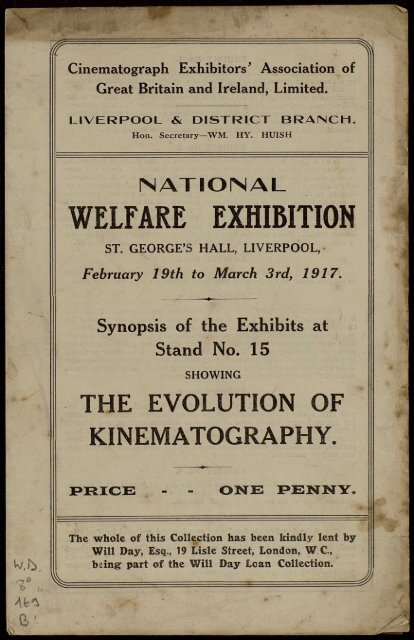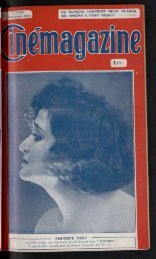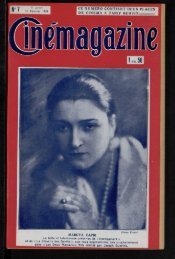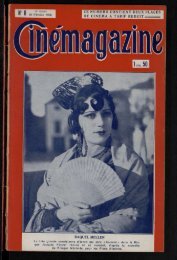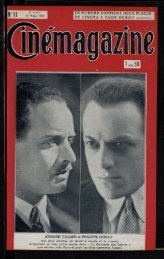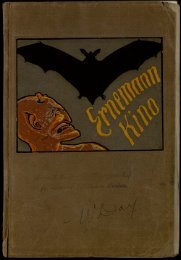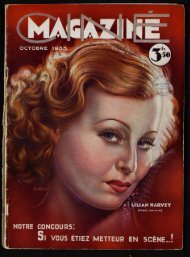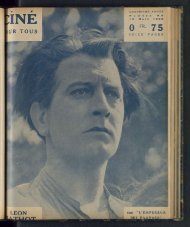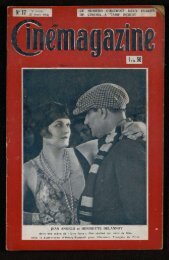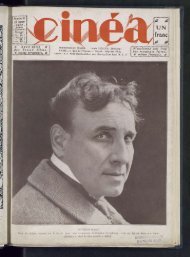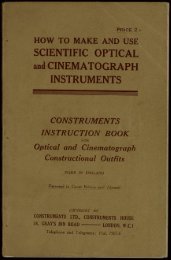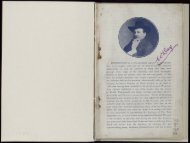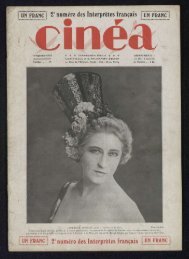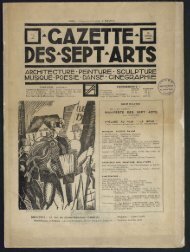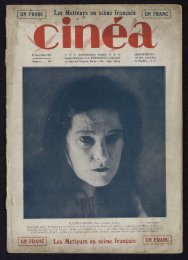WELFARE EXHIBITION
WELFARE EXHIBITION
WELFARE EXHIBITION
You also want an ePaper? Increase the reach of your titles
YUMPU automatically turns print PDFs into web optimized ePapers that Google loves.
Cinematograph Exhibitors' Association of<br />
Great Britain and Ireland, Limited.<br />
LIVERPOOL & DISTRICT BRAINCH.<br />
Hon. Secretary—WM. H Y. HUIS H<br />
NATIONAL<br />
<strong>WELFARE</strong> <strong>EXHIBITION</strong><br />
ST. GEORGE'S HALL, LIVERPOOL,<br />
February 19th to March 3rd, 1917.<br />
Synopsis of the Exhibits at<br />
Stand No. 15<br />
SHOWING<br />
THE EVOLUTION OF<br />
KINEMATOGRAPHY.<br />
PRICE - - ONE PENNY.<br />
The whole of this Collection has been kindly lent by<br />
Will Day, Esq., 19 Lisle Street, London, W C,<br />
being 1 part of the Will Day Loan Collection.
EXH1BIT NO. 1.<br />
Zoetrope, known also as the Zootrope or Wheel of Life, wn.ch was patentée!<br />
by a Frenchman named Desvignes, but it is a well-known faet that previously<br />
to this there was in use the Phcnakistoscope, whicli was shown at the Polytechnic,<br />
and was invented in lbd3, and is mentioned by W. G. Horner in the<br />
Philosophical Magazine, giving the name to the instrument of the Daedalium,<br />
which instrument gives every needful détail that can be attached to the Zoetrope,<br />
and although not patenled until the year 1860 'by Desvignes, was undoubtedly<br />
invented by an Englishman a great many years anterior to this date.<br />
EXHIBIT NO. 2.<br />
Is an original Beale's Choreutoscope, invented by Mr. Beale, of Greenwich,<br />
who was well-known to the présent owner of this instrument, and a box containing<br />
sliders wmch were painted for Mr. Beale by Mr, George Emmerson,<br />
of Peckham. This is absolutely the lirst instrument ever manufactured to be<br />
adapted to the Opïicàl Lantern to portray life motion to pictures, and it is<br />
interesting to note that in this instrument is contained ail the essential features<br />
of a modem Kinematogrnph Projector. It will be noted there is the Maltese<br />
Cross in elongated form, and brass Cam with Strjking Pin to impart movement<br />
to same, Oscillating Shutter to mask the movement, and a Rotating Handle to<br />
impart motioii. There are also long glass Sliders wi'th figures painted thereon<br />
to take the place of the modem films ; this was invented in the year 1866.<br />
EXHIBIT NO. 3.<br />
Is a set of 11 books of Linnett's Patent Kineograph, invented by Mr. Linnett<br />
in the year 1868. It will be noted that thèse pictures are ail from wood cuts.<br />
EXHIBIT NO. 4.<br />
Original Lantern Slides showing how movement was adapted for Projection,<br />
and applicd to the Optical Lantern about the same date as Beale invented his<br />
Choreutoscope. 1 Slipping slide, Clown and Policeman; 1 Rotary Slide, 1<br />
Astronomical slide showing various movements, and 1, 3-movement Lantern<br />
Slide showing apparent motion and how clever effects were produced before the<br />
advent of Kinematographv. The slide depicts a joumey from Dover to Calais<br />
by Paddle Steamer. The Steamer leaving l'ort of Dover, passing various ships<br />
in the Channcl, and arriving at Calais Harbour. It will be noted that the waves<br />
move, the ship rocks, and the Paddle Wheel revolves.<br />
EXHIBIT No. 5.<br />
Praxinoscope Théâtre, invented by Professor Raynaud, of Paris, in the<br />
year 1877, a very clever adaptation of the earlicr Zoetrope, producing apparent<br />
life motion from a printed banc! of ligures in différent settings, and brought<br />
before the eye as a composite moving pictures by a séries of rotating mirrers.<br />
This method was also adapted by the» same Professor in proieçting thèse<br />
pictures, and although severely handicapped by the light in use at that date<br />
was cntirely a success.<br />
EXHIBIT NO. 6.<br />
The first pair of Bi-unial Lanterns with the original Àrgand Oil Lamps, as<br />
used by Professor Child, Malden and others in their famous Phantasmajoria<br />
entertainments at the Royal Polytechnic Instituts.<br />
EXHIBIT NO. 7.<br />
One of the lirst Electric Arc Lamps ever invented and used for Projection<br />
purposës. To obtain the light for this Arc Lamp a 6-Cell Graves Battery was<br />
used", and the éléments for the Light were fwo sticks of Charcoal. A light of<br />
apprqxirhately 5 ampères was obtained, and it is amusing to recall the inventor's<br />
remarks in staling that the heat generated was enormous, and anything greater<br />
jvould certainly endanger the Condensers.<br />
EXHIBIT No. 8.<br />
The original pièce of paper film produced by Eriese Greene, who is undoubtedly<br />
the inventer of the Kinematograph as we know it to-day. This was<br />
the first lime that ever a séries of Photographs had been taken from one<br />
stafldpoint, on one endless band of film, by one Caméra and recorded so that<br />
Life .Movement Portrayals could be reproduced with the aid of the Optical<br />
Lantern and shown to a tiumber of pcople apparently as they occurred. This<br />
film was takeh on paper in the early efforts of Eriese Greene in the year 1885,<br />
and was used on the first instrument invented by Eriese Greene, and to authenticate<br />
the data it is interesting fo see the telegram which accompanies this<br />
remarkable relie, from the Enginecr Lege, of Hatton Garden, who made this<br />
first instrument for Eriese Greene. The photographs after being fixed were<br />
immersed in Parafiin Wax to render them semi «ransparent, and the subject<br />
was a row of shops with the Sun blinds ont, at Hyde Park Corner, and at this<br />
effort no shutter was used to mask the movement, îience the streaky light effect.<br />
It is also interesting to record that many of dur leadirig manufacturers of<br />
Moving Pîctùre Apparatus, and perfectors of Kinematographv ail take their<br />
data, and were undoubtedly instilled in the ethics of Motion Picture Photographv<br />
by Eriese Greene, such as T. Alva Edison, who is credited with the<br />
invention of Kinematographv, John Wrench, R. Pricstwich, Darling of<br />
Brighton, and many other well-known manufacturers of apparatus.<br />
EXHIBIT NO. 9.<br />
Label taken from an early Kinetoscope invented by Thomas Alva Edison,<br />
who was working on Motion Pictures after receiving correspondence from<br />
Eriese Greene in 1887. This was never patented by this gentleman in this<br />
country, and the first intimation of his work on Living Pictures reached England<br />
in May, 1891, so that undoubtedly although we hâve a great dcal to thank this<br />
wizard of inventive facultv for, it is a façt established beyond any doubt whatever<br />
that he dfd not invent Motion Pictures. The lirst of thèse Kinetoscope<br />
Machines was brought to England by Messrs. Maguire and Borcas, and installée!<br />
in an office in Bishopsgatc Street.<br />
EXHIBIT NO. 10.<br />
One of the original séries of films manufactured by Mr. Edison in his<br />
carliest productions, showing the exact length of films at that period, namely,<br />
r> fret, and showing the Edison Standard (.auge, namely, four perforations per<br />
picture, which gauge lias been since universally adapted nie world over. The<br />
Film shows a scène in a Blacksmith's shop, and was produced about the year<br />
1891.<br />
EXHIBIT No. 11.<br />
One Lumière Fire Proof Film Box, made to-take the standard length of<br />
film of that period, namely, 45 feett, and was invented about 1898.<br />
EXHIBIT NO. 12.<br />
A p'ortion of the first film ever takeh by Mr. Bert Acres for R. W. Paul,<br />
who manufactured the first commercial i rojectors in this country, and showeel<br />
his first Kinematograph Pictures at Einsbury Technical Collège on February<br />
20th, 1896. It will be noted that the perforations are not correctly centred.<br />
This fact is attributcd to the early film manufactured by Mr. Paul being<br />
perforated by a hand punch, having 32 teeth on either siele, which in use<br />
sometimes came truc, and sometimes did not.<br />
EXHIBIT No. 13.<br />
An Animatograph Maltese Cross Projector, manufactured by R. W. Paul<br />
in the year 1903, showing how much advanced in constructional détails this<br />
machine was over ail others of the period. This was one of the last efforts of<br />
this well-known mechanic, who did so much to produce Motion Pictiire<br />
Apparatus, and to him undoubtedly must be credited the fullest mede of praise<br />
for his early efforts in producing Caméras, Projectors, and ail necessary<br />
apparatus for Tue projection of Motion Pictures, w'hîch he started after showing<br />
an Edison Kinetograph early in the year 1895.
EXHIBIT No. 14.<br />
One Filoscope Booklet of Animated Photographs, invented by H. W.<br />
Short, and patented, No. 23, 158, on the 3rd November, 1S98.<br />
EXHIBIT NO. 15.<br />
rtii Original Mu'tograpn Caméra, invented and designed by Casier, and<br />
patented in the year 1897. This Caméra was used to take the Finis for the<br />
Palace Théâtre, London, and was fitted with Iwo perforators which punched<br />
two fioles in the films at the exact moment the exposure was made This<br />
perforation was again made in the subséquent positive film when printed from<br />
the négative at the exact moment contact was made, and thèse perforations<br />
were again locked in the Biograph Projectorat the exact moment that the<br />
film was exposed and stationary. Thèse piclûres were known for their extrême<br />
steadiness, and this factor of synchronisation of perforations is one that couid<br />
well be adapted to modem production. It will be noted that ail the driving<br />
portions of this mechanism are by Friction' and Belts.<br />
EXHIBIT NO. 16.<br />
An original Mutograph Négative, taken on the above Caméra of the Launch<br />
of a Battlcship. Note Perforations in centre of Picture. The film is 2JLn. in<br />
Width, and the pfetures are 2in. x 2$în.<br />
EXHIBIT No. 17.<br />
An early Lumière Projector, Printer and Caméra combinée!, made to carrv<br />
50 feet of Film. This instrument is said to have been the property of Professer<br />
Trcwev, who showed the first Kinematograph Pictures for Lumière et Fils of<br />
Parts, at the Regent Street Polvtecnnic, Februarv, 1896.<br />
EXHIBIT NO. 18.<br />
An original Lumière Film of the Rougit Sea. One of the best knenvn and<br />
most talked of pictures of Lumiere's early subjects. Note the perforation holes<br />
are 4 per picture. The Spoeil is also the original Lumière Spool.<br />
EXHIBIT NO. 19.<br />
An early Rotary Perforator, manufactured bv Mr. Darling, of Brighton,<br />
date about Ï899.<br />
EXHIBIT NO. 20.<br />
An early W'ray Kinematograph Projector, manufactured by Mr. Beard, of<br />
London, and largely used by ail the leading Showmen about the year 1S99.<br />
EXHIBIT NO. 21.<br />
An early Kinematograph Projector, made by Air. Rne, of Bradford. Date<br />
about 1900, showing the method e>f driving the mechanism almost universallv<br />
adoplcel at that period, namely, by Rubber Boit Transmission from a large<br />
wheel on Lamphouse.<br />
EXHIBIT NO. 22.<br />
A Kinora Motion Picture Projector, the inventors of which were Messrs.<br />
Lumière' et Fils, portraying in a simple mariner Life-movcment Photographs,<br />
'date 189S.<br />
EXHIBIT No. 23.<br />
A Constructional Mode), showing çlearly the détails of the methods tmployed<br />
in giving the exhibition of Kineplasticon pictures at The Scala Théâtre,<br />
London. The application is only anolher form of the Original Peppcr's Ghost,<br />
which mystified the public very many years previous at the Royal Polytechnic<br />
Instituts.<br />
U)D 4


